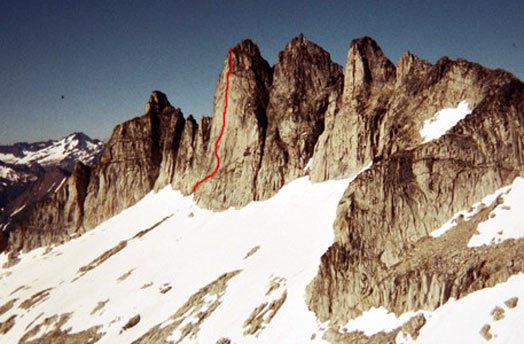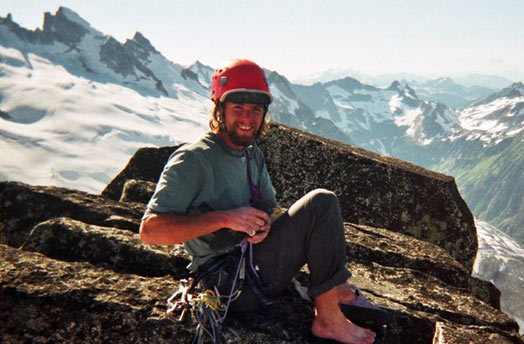
The west faces (from left to right) of Northeast Gunsight, North Gunsight (marked with an approximate line of the first free ascent by Jens Holsten and Max Hasson), Middle Gunsight and South Gunsight (all between 8,000′ and 8,200′), Glacier Peak Wilderness Area, Cascades, Washington. Holsten and Hasson onsighted the face, one of the hardest alpine free climbs in the Cascades, on July 25. [Photo] Max Hasson
The west face of North Gunsight peak, Glacier Peak Wilderness Area, Cascades, Washington, now one of the hardest free alpine lines in the range, was climbed onsight and all free on July 25 by young alpinists Jens Holsten (24) and Max Hasson (23). Established by Jim Nelson (prolific first ascensionist, guidebook author and Seattle gear shop owner) and Carl Dietrich in 1986 at 5.10 A1, via a slightly different variation (the pair placed three bolts that no other parties have encountered), the face likely was not repeated until last year, when Blake Herrington and John Frieh climbed it on July 10, 2006, at the same grade (see the August 1 NewsWire for Herrington’s FA report of Gunrunner, which traverses the four Gunsight peaks). A trip report that Herrington posted on cascadeclimbers.com last summer rejuvenated activity in the remote area. Over the past year numerous parties have attempted the face, which now has four recorded ascents, including Holsten and Hasson’s free variant.

Holsten on the cruxy second pitch, nearly through the route’s most difficult section. Following the initial crack is a very thin step across left, which accesses the steep cracks and flakes where Holsten is visible. [Photo] Max Hasson
Although only five to six pitches in length, the west face of North Gunsight is “very steep, and among the hardest free climbs in the cascades,” Herrington said, “and maybe the hardest given the approach,” which required two days of strenuous hiking, log climbing and bushwhacking through slide alder and devil’s club. The pair onsighted the face, taking no falls, and graded it 5.11c. “If the crux was at your local crag it very well might be easier,” Hasson said. “But when you have to carry crampons, ice ax, and approach shoes on an onsight effort in the middle of nowhere, after a day and a half of brutal approach, [the climbing becomes more challenging].” The pair camped on the east side of the peaks, on the Blue glacier, where they had excellent views of Glacier Peak and the North Cascades.
Holsten and Hasson completed the climb in five pitches, swinging leads. Hasson said the route featured varied climbing on flaky (due to the low volume of climbing that the remote area sees) but excellent rock with good gear that offers everything from incipient flakes and bulbous knobs to wide stemming and lieback sections. They found the steep moves on Pitch 2 the crux of the route. The next length involved “5.10++ flaring flakes, and Pitch 4 had the notorious but surprisingly mellow wide section, probably 5.10+,” Hasson said. The rock quality deteriorated slightly for the following two pitches that brought them to the summit of North Gunsight.
Rather than chance the potentially treacherous descent down the east side of the peak with a single sub-60-meter rope, they traversed south, having obtained beta from Herrington. They rapped, downclimbed and traversed to Middle Gunsight, then to South Gunsight before rappelling to the glacier off a sling left by Herrington and Dan Hilden during their first ascent of Gunrunner on July 9. Holsten and Hasson spent the next two days returning home.
“This flurry of activity [around the Gunsights] in the last two years represents probably as many climbers as the range had seen in the prior twenty [years],” Herrington said. “Shows you what the internet and some good digital photos can do, eh?”

Holsten enjoying success atop the remote, but increasingly popular, North Gunsight. It took him and Hasson two days to approach the climb, and two days to descend back to their vehicle. [Photo] Max Hasson